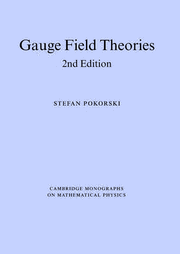Book contents
- Frontmatter
- Contents
- Preface to the First Edition
- Preface to the Second Edition
- 0 Introduction
- 1 Classical fields, symmetries and their breaking
- 2 Path integral formulation of quantum field theory
- 3 Feynman rules for Yang–Mills theories
- 4 Introduction to the theory of renormalization
- 5 Quantum electrodynamics
- 6 Renormalization group
- 7 Scale invariance and operator product expansion
- 8 Quantum chromodynamics
- 9 Chiral symmetry; spontaneous symmetry breaking
- 10 Spontaneous and explicit global symmetry breaking
- 11 Higgs mechanism in gauge theories
- 12 Standard electroweak theory
- 13 Chiral anomalies
- 14 Effective lagrangians
- 15 Introduction to supersymmetry
- Appendix A Spinors and their properties
- Appendix B Feynman rules for QED and QCD and Feynman integrals
- Appendix C Feynman rules for the Standard Model
- Appendix D One-loop Feynman integrals
- Appendix E Elements of group theory
- References
- Index
Preface to the First Edition
Published online by Cambridge University Press: 13 January 2010
- Frontmatter
- Contents
- Preface to the First Edition
- Preface to the Second Edition
- 0 Introduction
- 1 Classical fields, symmetries and their breaking
- 2 Path integral formulation of quantum field theory
- 3 Feynman rules for Yang–Mills theories
- 4 Introduction to the theory of renormalization
- 5 Quantum electrodynamics
- 6 Renormalization group
- 7 Scale invariance and operator product expansion
- 8 Quantum chromodynamics
- 9 Chiral symmetry; spontaneous symmetry breaking
- 10 Spontaneous and explicit global symmetry breaking
- 11 Higgs mechanism in gauge theories
- 12 Standard electroweak theory
- 13 Chiral anomalies
- 14 Effective lagrangians
- 15 Introduction to supersymmetry
- Appendix A Spinors and their properties
- Appendix B Feynman rules for QED and QCD and Feynman integrals
- Appendix C Feynman rules for the Standard Model
- Appendix D One-loop Feynman integrals
- Appendix E Elements of group theory
- References
- Index
Summary
This book has its origin in a long series of lectures given at the Institute for Theoretical Physics, Warsaw University. It is addressed to graduate students and to young research workers in theoretical physics who have some knowledge of quantum field theory in its canonical formulation, for instance at the level of two volumes by Bjorken & Drell (1964, 1965). The book is intended to be a relatively concise reference to some of the field theoretical tools used in contemporary research in the theory of fundamental interactions. It is a technical book and not easy reading. Physical problems are discussed only as illustrations of certain theoretical ideas and of computational methods. No attempt has been made to review systematically the present status of the theory of fundamental interactions.
I am grateful to Wojciech Królikowski, Maurice Jacob and Peter Landshoff for their interest in this work and strong encouragement. My warm thanks go to Antonio Bassetto, Wilfried Buchmüller, Wojciech Królikowski, Heinrich Leutwyler, Peter Minkowski, Olivier Piguet, Jacek Prentki, Marco Roncadelli, Henri Ruegg and Wojtek Zakrzewski for reading various chapters of this book and for many useful comments, and especially to Peter Landshoff for reading most of the preliminary manuscript.
I am also grateful to several of my younger colleagues at the Institute for Theoretical Physics in Warsaw for their stimulating interactions. My thanks go to Andrzej Czechowski for his collaboration at the early stage of this project and for numerous useful discussions. I am grateful to Wojciech Dębski, Marek Olechowski, Jacek Pawełczyk, Andrzej Turski, Robert Budzynski, Krzysztof Meissner and Michał Spalinski, and particularly to Paweł Krawczyk for checking a large part of the calculations contained in this book.
- Type
- Chapter
- Information
- Gauge Field Theories , pp. xviiPublisher: Cambridge University PressPrint publication year: 2000

